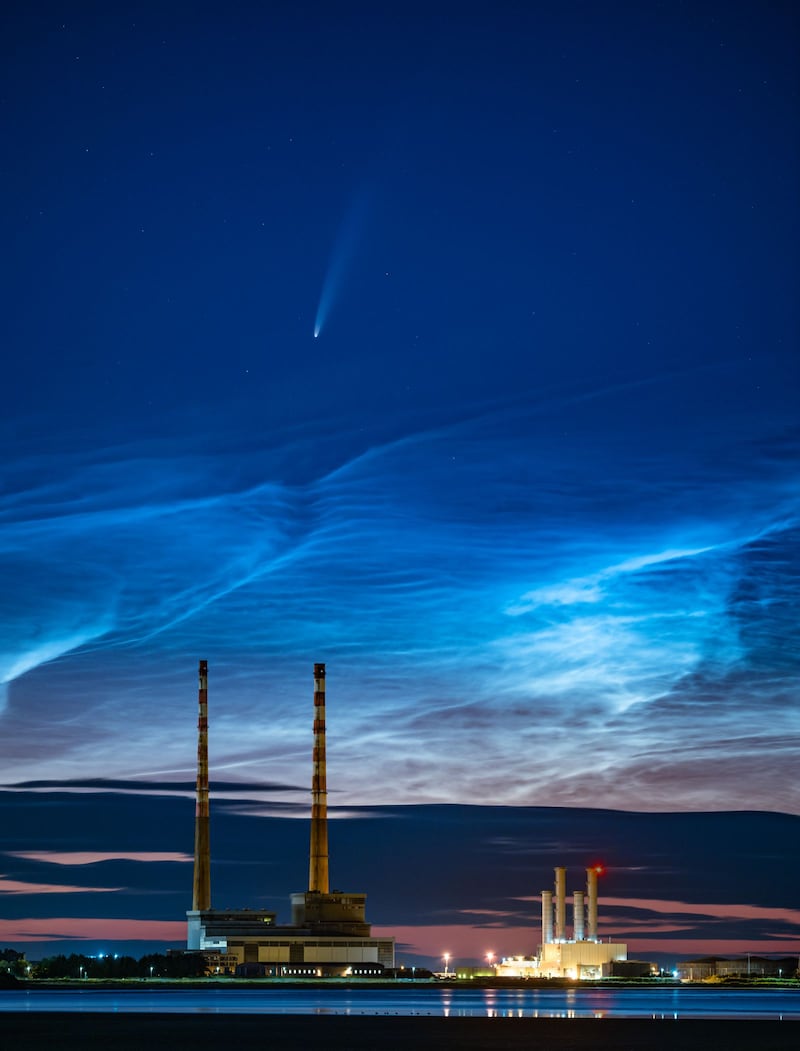Comet Neowise is the brightest in the Northern Hemisphere this century, but the weather has been less than kind for skyviewers in Ireland.
Persistent cloud has inhibited sightings of the comet, which is visible to the naked eye in dark skies and easily picked out in a binoculars even in light polluted locations.
Astrophotographer Dr Antonio Martin Carrillo took advantage of a rare break in the clouds to capture a stunning image of comet Neowise over the Poolbeg power station and the incinerator nearby by in the early hours of Saturday morning.
The photograph was taken from Merrion Strand and Dr Carrillo was rewarded for his patience when the clouds parted.
“ During the night the sky truly delivered, not only removing the clouds but giving us some of the brightest noctilucent clouds in some time. It was an incredible show with the comet still visible to the naked-eye and blue colours taking up the whole sky,” he said.
Noctilucent cloud (NLC) are wispy clouds seen between latitudes 50 and 60 degrees north during summer time.

Dr Carillo is an assistant professor at University College Dublin (UCD) where he lecture in astrophysics. His research focuses on searching for the electromagnetic counterparts of gravitational waves and the study of gamma-ray bursts, the most violent explosions in the universe since the Big Bang.
He also runs an outreach project, called Skywonders(http://skywonders.ie) with the aim of explaining the science in astrophotography.
The image is the composite of 11 separate photographs of the comet taken with a Canon EOS Ra, a mirrorless camera especially adapted for astrophotography. He used a Samyang 135mm lens with the aperture open at f2 and each of the photographs taken at short interval was exposed for a third of a second.
The images were later processed with Lightroom and Starry Landscape stacker, two apps used in astrophotography.
There is still time to see the comet in Irish skies as it will be visible all night from Tuesday night low in the north for the next fortnight.
The comet was discovered last March by NASA’s Near-Earth Object Wide-field Infrared Survey Explorer (Neowise), hence its name, and reached perihelion – its closest point to the Sun – on July 3rd at a distance of 44 million kilometres.
Comets, by their fragile nature, sometimes fail to survive perihelion as the stresses from intense solar heating may cause them to fragment. Neowise has emerged intact and promises to be one of the best comets seen from here for the last number of years.
The body’s nucleus is only a few kilometres across but cannot be seen directly as it is buried in the bright coma form as material erupts from fissures on the surface.
Sunlight pressure pushes this mix of icy particles, gas, and dust outward to form a complex tail that can extend a million kilometres or more.
Reports from across Europe currently put Neowise as an easy binocular object with a stubby tail. Some experienced amateur astronomers have also managed to spot the comet as a star-like point with the unaided eye.
By the middle of this week the comet will be in a darker sky when the moon is absent until the early hours. Although it is likely to have faded a little by then, Neowise should still be a nice sight in binoculars and well worth seeking out a dark location away from urban areas to get a view.
Neowise is closest to Earth on July 23rd at a distance of 103 million kilometres. Unlike periodic comets like Halley, it has a 6,800 year orbit and is now heading back into the outer solar system deep freeze.








